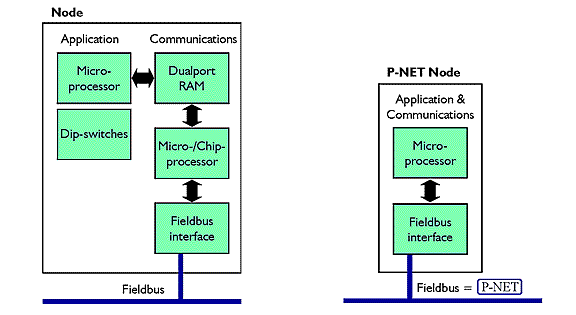Ease of P-NET Implementation
One of the reasons for the high number of P-NET installations now operating, can be related to the low cost of node implementation.
The principle of P-NET, is to use the same microprocessor to control the main task of the node (the application), as well as the communication task. Data is only stored in one location. By incorporating P-NET as an integrated part of the device, P-NET can be used to perform configuration and to read the status of the device.
Typically this means that dip-switches for selecting a baud rate and setting the node address can be avoided.
Other Fieldbus types use an add-on circuit in each node, in the form of a separate chip / microprocessor for communication. Data is exchanged through a dualport RAM.
This principle always results in a significantly higher cost for the final product.

There is no need for a specific chip-set when implementing the P-NET protocol, because the P-NET communication program for a slave requires only a few kbytes of code. This provides the opportunity to use a common standard single chip microprocessor, which includes a UART. e.g. H8- 300, 68HC11, 6805, 80851, 8051 etc.
It can be concluded therefore, that a P-NET Fieldbus node need be no more expensive than traditional microprocessor equipment, having no Fieldbus connection.
Many years of experience have been gained in the implementation of P-NET nodes, and assistance is available for manufacturers, through the International P-NET User Organization.Figure 9: P-NET implementation.